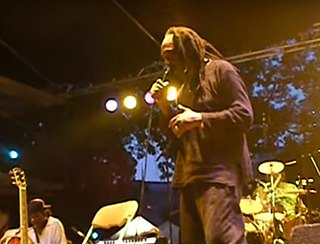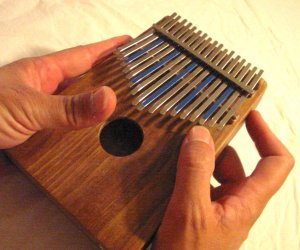
A percussion instrument is a musical instrument that is sounded by being struck or scraped by a beater including attached or enclosed beaters or rattles struck, scraped or rubbed by hand or struck against another similar instrument. Excluding zoomusicological instruments and the human voice, the percussion family is believed to include the oldest musical instruments. In spite of being a very common term to designate instruments, and to relate them to their players, the percussionists, percussion is not a systematic classificatory category of instruments, as described by the scientific field of organology. It is shown below that percussion instruments may belong to the organological classes of idiophone, membranophone, aerophone and chordophone.

The xylophone is a musical instrument in the percussion family that consists of wooden bars struck by mallets. Like the glockenspiel, the xylophone essentially consists of a set of tuned wooden keys arranged in the fashion of the keyboard of a piano. Each bar is an idiophone tuned to a pitch of a musical scale, whether pentatonic or heptatonic in the case of many African and Asian instruments, diatonic in many western children's instruments, or chromatic for orchestral use.

Mbira are a family of musical instruments, traditional to the Shona people of Zimbabwe. They consist of a wooden board with attached staggered metal tines, played by holding the instrument in the hands and plucking the tines with the thumbs, the right forefinger, and sometimes the left forefinger. Musicologists classify it as a lamellaphone, part of the plucked idiophone family of musical instruments. In Eastern and Southern Africa, there are many kinds of mbira, often accompanied by the hosho, a percussion instrument. It is often an important instrument played at religious ceremonies, weddings, and other social gatherings. The "Art of crafting and playing Mbira/Sansi, the finger-plucking traditional musical instrument in Malawi and Zimbabwe" was added to the UNESCO Representative List of the Intangible Cultural Heritage of Humanity in 2020.

Zimbabwean music is heavily reliant on the use of instruments such as the mbira, Ngoma drums and hosho. Their music symbolizes much more than a simple rhythm, as the folk and pop style styled music was used as a symbol of hope for Zimbabweans looking to gain independence from Rhodesia. Music has played a significant role in the history of Zimbabwe, from a vital role in the traditional Bira ceremony used to call on ancestral spirits, to protest songs during the struggle for independence. The community in Zimbabwe used music to voice their resistance to their oppression, as one of the only weapons they had available to fight back with. In the eighties, the Music of Zimbabwe was at the center of the African Music scene thanks to genres such as Sungura and Jit. However, several performers were banned by state TV and radio leading to the closing of several music venues.

Thomas Tafirenyika Mapfumo is a Zimbabwean musician. He is nicknamed "The Lion of Zimbabwe" and "Mukanya" for his immense popularity and for the political influence he wields through his music, including his sharp criticism of the government of former Zimbabwean president Robert Mugabe. He both created and popularized Chimurenga music, and is known for his distinctive voice and slow-moving style.

A lamellophone is a member of the family of musical instruments that makes its sound by a thin vibrating plate called a lamella or tongue, which is fixed at one end and has the other end free. When the musician depresses the free end of a plate with a finger or fingernail, and then allows the finger to slip off, the released plate vibrates. An instrument may have a single tongue or a series of multiple tongues.
Shona music is the music of the Shona people of Zimbabwe. There are several different types of traditional Shona music including mbira, singing, hosho and drumming. Very often, this music will be accompanied by dancing, and participation by the audience. In the Shona style of music, there is little distinction between the performer and the audience. Both are often actively involved in the music-making and both are important in the Shona religious ceremonies.
Ephat Mujuru (1950–2001), was a Zimbabwean musician, one of the 20th century's finest players of the mbira, a traditional instrument of the Shona ethnic group of Zimbabwe.
Abraham Dumisani Maraire, known to friends as "Dumi", was a Zimbabwean musician. He was a master performer of the mbira, a traditional instrument of the Shona people of Zimbabwe. He specialized in the form of mbira called nyunga nyunga, as well as the Zimbabwean marimba. He introduced Zimbabwean music to North America, initiating a flourishing of Zimbabwean music in the Pacific Northwest that continues into the 21st century.

The Shona people are a Bantu ethnic group native to Southern Africa, primarily living in Zimbabwe where they form the majority of the population, as well as Mozambique, South Africa, and a worldwide diaspora. There are five major Shona language/dialect clusters: Manyika, Karanga, Zezuru, Korekore, and Ndau.

Ngoma are musical instruments used by certain Bantu populations of Africa. Ngoma is derived from the Kongo word for "drum". Different Bantu-inhabited regions have their own traditions of percussion, with different names for their instruments. In Kikongo, "ngoma" is used by extension to signify specific dances, social occasions, and rhythms. In Swahili, Ngoma music is used to describe music, dance, instruments including the drums, and events together as a joint cultural practice.

Forward Kwenda is a mbira performer from Zimbabwe. He was given the name "Forward" due to his involvement in many activities including his performances for guerrilla forces during the Rhodesian Bush War.

Dancing in Zimbabwe is an important aspect of the Zimbabwean culture, tradition, spirituality and history. There are many dances that reflect the culture of the people, although the dances may have changed throughout the years. Ethnic diversity is also a key factor in influencing the dances of the Zimbabwean culture. These dances are self-reflective, for the entire community because all music and dance are communal events. Dance to Zimbabweans is a very spiritual, powerful tool that carries on traditions, and chronicles the important events of their history and culture.
Robert Garfias is an American ethnomusicologist and musicologist. He is a professor of Anthropology and a member of The Social Dynamics and Complexity Group at the University of California, Irvine as well as a professor at the Japanese National Museum of Ethnology in Senri, Osaka.
Queen Marimba is a folk hero whose accomplishments have become part of the folklore of Africa. As is customary in most African cultures she is considered to be a god and was one of the immortals. She led the Akamba tribe in East Africa in very ancient times across the Ukambani plains in present day Kenya, stretching across the Kilimanjaro plains in present day Tanzania. There has been scant research done on her and presently the most notable source for information on her life comes from the writings of Vusa'mazulu Credo Mutwa. He asserts in his book; Indaba My Children, that she was the mother of the Akamba people at the time when they were getting to know their Maasai neighbours. Various renditions of his book have been published since the late 60's, including "My People, My Africa", "Indaba My Children" and "Africa Is My Witness."
A marimba is a xylophone-like percussion instrument played with mallets.
Bira is an all-night ritual, celebrated by Shona people from Zimbabwe in which members of an extended family call on ancestral spirits for guidance and intercession. Shona people believe that the only ones who can communicate with both the living and God are the ancestral spirits, or dzavadzimu. These spirits are summoned during the Bira ceremonies through the use of music and ritual dance. Bira ceremonies are also held to welcome back the spirit of an ancestor into the home where a family member is a svikiro who is occasionally possessed by one or more ancestors.
Mhande is a traditional performance practiced among the Shona people, involving music and dance. It is a vital element of the mutoro ceremony, an annual rain ritual of the Karanga.

Chamunorwa is an album by the Zimbabwean musician Thomas Mapfumo, released in 1991. He is credited with his band, Blacks Unlimited. The title translates to What Are We Fighting For. Chamunorwa was Mapfumo's final album for Mango Records.











